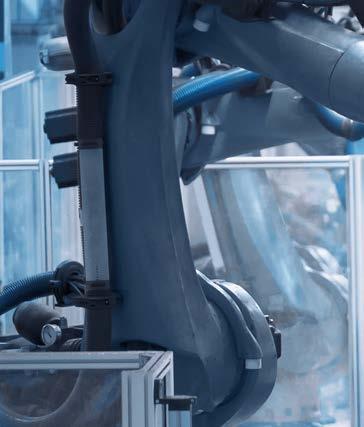
3 minute read
The first industrial robot
It was a love of Isaac Asimov’s sci-fi writings, plus a fortuitous meeting with the American inventor George Devol at a cocktail party in 1956, that drove the engineer and entrepreneur, Joseph Engelberger, to form the world’s first-ever robot company. Two years previously, Devol had invented the Unimate, the first-ever digitally operated and programmable robot.
In 1961, the Unimate #001 prototype was sold to General Motors and put to work in its New Jersey automobile factory. Later, in 1969, GM’s recently rebuilt plant in Lordstown, Ohio, reported that its army of Unimate 1900 spot welding robots were building 110 cars per hour. These speeds, never achieved before, were double the rate of any other automotive plant at that time.
Advertisement
With these origins, it is clear that robots have always been desired for their speed, efficiency and controllability – and, of course, their benefits to the bottom line. With the Unimate 1900 series, GM jumped ahead of its competition while becoming the world’s most automated car manufacturer. Yet, while the Unimate is undoubtedly one of civilisation’s most significant technological feats, its legacy also includes some of the largest challenges faced when applying robots to industrial settings.
Robots of previous years have been large, cumbersome – the Unimate #001 prototype weighed 2,700 pounds – and limited, in terms of both their design and the limited protocols used to control them. Industrial businesses often required specialised programmers and staff to control and program these robots, which made them inflexible for different working environments as well as expensive.
Today’s engineers and designers are still striving to create more innovative, compact, lightweight and enduring robots – none of which are limited to the pages of science fiction, any longer!

Gradually, we are seeing the rise of the machines. According to the 2019 New Robotics report by the International Federation of Robotics (IFR), 2018 saw an annual record of $16.5 billion in sales of industrial robots. This was a six per cent increase over the previous year and, going forward, the IFR forecasts an average growth of 12 per cent, per year, up to the year 2022.
We expect that this growth will be driven by the automotive segment, yet it’s clear that robots will be increasingly demanded in other segments, too, like food and beverage. Whatever the industry, there are certain common industry challenges.
Firstly, robot designs must fit into smaller spaces to suit manufacturers’ growing concerns over “machine real estate”, which means that every square metre of production space is used for production. There is also the ongoing question of how robots can fit in with Industry 4.0 technologies such as virtual and augmented reality and artificial intelligence (AI). This requires a level of connectivity and controllability that integrates,

quickly and seamlessly, into the smaller spaces of any production line.
It is not simply a question of deploying more robots. There are also crucial questions of how best to implement these robotic systems, given the above challenges. That’s why SMC maintains close working relationships with our customers like original equipment manufacturers (OEM), machine builders and end users. This is reinforced by SMC’s 8,400 sales engineers across 83 countries, 36 production centres and five technical centres, worldwide.
Working closely with our customers inspires SMC to find new ways to help evolve their robots for new applications. Some of these innovations are described over the following pages.
“ SMC has implemented its own Voice of the Customer (VoC) programme, which are increasingly popular within industry as a way to capture customers’ preferences and opinions. SMC will produce 3D-printed prototypes and take these to the customer, to inspire them and present them with something tangible. This process is especially beneficial in robotics where, what initially seems like a small gain can have a significant knock-on effect. ” Peter Humphreys, Product Manager, SMC UK









